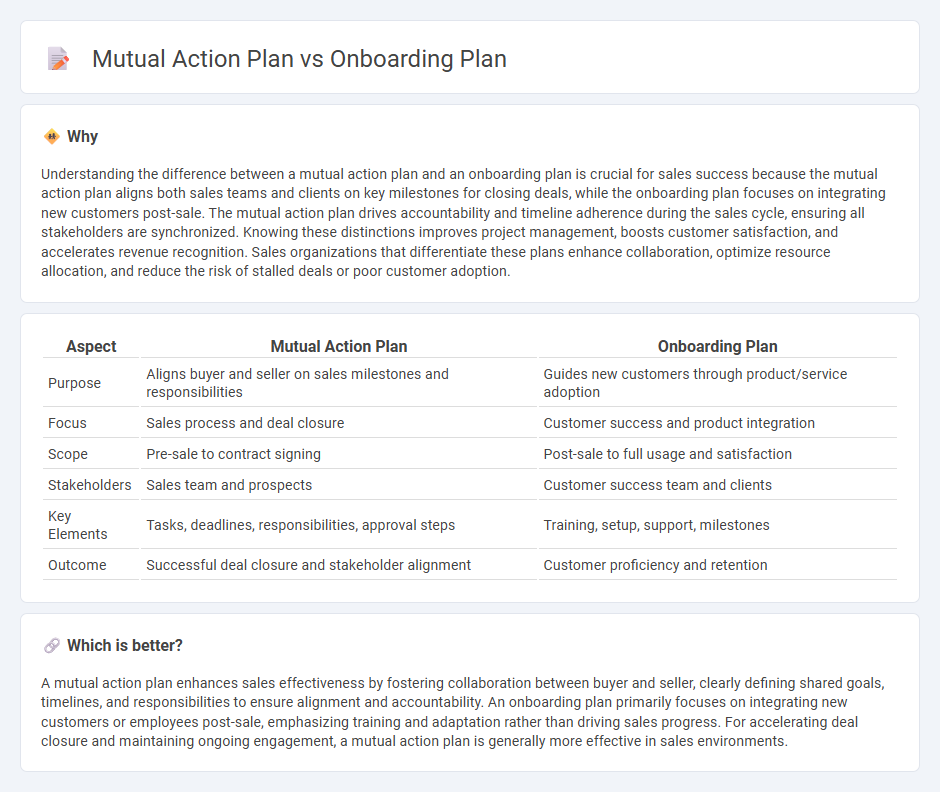
A mutual action plan aligns sales teams and clients by outlining shared goals, timelines, and responsibilities to ensure a seamless deal closure. In contrast, an onboarding plan focuses on post-sale activities designed to integrate new customers, optimize product adoption, and drive long-term satisfaction. Explore how leveraging both strategies can enhance customer success and accelerate revenue growth.
Why it is important
Understanding the difference between a mutual action plan and an onboarding plan is crucial for sales success because the mutual action plan aligns both sales teams and clients on key milestones for closing deals, while the onboarding plan focuses on integrating new customers post-sale. The mutual action plan drives accountability and timeline adherence during the sales cycle, ensuring all stakeholders are synchronized. Knowing these distinctions improves project management, boosts customer satisfaction, and accelerates revenue recognition. Sales organizations that differentiate these plans enhance collaboration, optimize resource allocation, and reduce the risk of stalled deals or poor customer adoption.
Comparison Table
| Aspect | Mutual Action Plan | Onboarding Plan |
|---|---|---|
| Purpose | Aligns buyer and seller on sales milestones and responsibilities | Guides new customers through product/service adoption |
| Focus | Sales process and deal closure | Customer success and product integration |
| Scope | Pre-sale to contract signing | Post-sale to full usage and satisfaction |
| Stakeholders | Sales team and prospects | Customer success team and clients |
| Key Elements | Tasks, deadlines, responsibilities, approval steps | Training, setup, support, milestones |
| Outcome | Successful deal closure and stakeholder alignment | Customer proficiency and retention |
Which is better?
A mutual action plan enhances sales effectiveness by fostering collaboration between buyer and seller, clearly defining shared goals, timelines, and responsibilities to ensure alignment and accountability. An onboarding plan primarily focuses on integrating new customers or employees post-sale, emphasizing training and adaptation rather than driving sales progress. For accelerating deal closure and maintaining ongoing engagement, a mutual action plan is generally more effective in sales environments.
Connection
A mutual action plan outlines the shared responsibilities and timelines between sales teams and clients to ensure a smooth transaction, while the onboarding plan focuses on integrating new customers effectively after the sale. Together, these plans align expectations, facilitate collaboration, and enhance customer satisfaction by providing clear guidance from initial contact through successful product adoption. Coordinating these strategies improves sales cycle efficiency and drives long-term client retention.
Key Terms
**Onboarding Plan:**
An onboarding plan outlines a structured process for integrating new employees or clients, detailing specific training modules, milestones, and resources to ensure smooth adaptation and productivity. It emphasizes role clarity, goal alignment, and continuous support to foster engagement and retention. Discover how an effective onboarding plan can transform your team's performance and satisfaction.
Training Schedule
Onboarding plans prioritize employee integration through detailed training schedules that outline specific milestones and learning objectives tailored to new hires. Mutual action plans emphasize collaborative timelines between clients and vendors, aligning training sessions with project goals to ensure both parties achieve shared outcomes. Explore comprehensive strategies to optimize your training schedule by balancing onboarding plans with mutual action plans for enhanced results.
Role Clarification
An onboarding plan centers on role clarification by defining specific job responsibilities, expectations, and performance goals for new employees to ensure a smooth integration into the company. In contrast, a mutual action plan outlines collaborative steps and shared responsibilities between teams or stakeholders to achieve common objectives, emphasizing alignment and accountability. Explore our detailed comparison to understand how these frameworks enhance role clarity and drive success.
Source and External Links
4 Steps to Create an Employee Onboarding Process - Outlines four key steps to design an onboarding process, emphasizing the creation of a structured timeline that covers pre-arrival logistics, first-day introductions, and ongoing training, with clear communication about the process length and expectations.
Employee onboarding: What it is, steps, and 6 free checklists - Offers step-by-step guidance and downloadable checklists for pre-onboarding, first-day activities, and 30/60-day milestones, helping HR teams organize and track each stage of the new hire's integration.
19 Best Onboarding Process Examples To Inspire You - Features real-world onboarding strategies including a 30-60-90 day plan focused on gradual integration, team introductions, system familiarization, and regular manager check-ins to ensure smooth acclimation.
 dowidth.com
dowidth.com